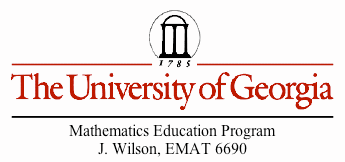
ANCIENT
EGYPTIAN MATHEMATICS AND COMPUTERS
By Leighton McIntyre
Mathematical Documentation
of the Ancient Egyptians
Early
Egyptians carved their numbers (hieroglyphic writing) in temples , vases, and stone monuments. Later they
developed writing on papyrus (plural papyri). Papyri were easily destroyed but
two important papyri still exist to date. They are the Rhind (Ahmes ) Papyrus
for which the name of the scribe was Ahmes in 1650 BC and the Moscow
Papyrus for which no scribe was
named. Both the Rhind(Ahmes ) papyrus and the Moscow papyrus contain problems
that involve practical applications as well as the manipulation of number
system without any given practical applications. Many of the problems involved
division and multiplication even involving fractions. For example the first six
problems of the Rhind(Ahmes ) papyrus asks how to divide n loaves of bread between
10 men. The Rhind(Ahmes ) papyrus contains 87 mathematical problems while the Moscow
papyrus contains 25 mathematical examples.
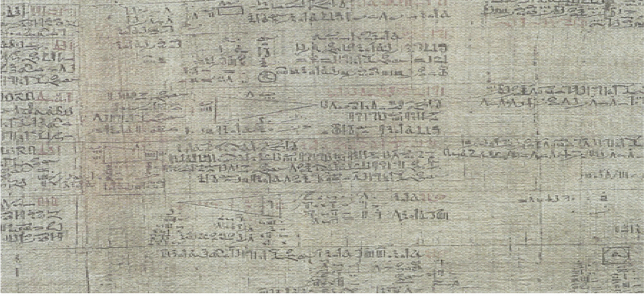
Rhind
(Ahmes) Papyrus.
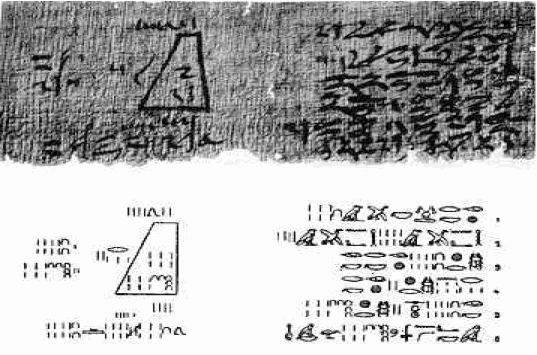
Moscow
Papyrus.
The Ancient Egyptian Number
System
The
Egyptian Number system uses one stroke (I) to represent the number a symbol looking
our symbol for set intersection (ā) to represent 10, a picture
looking like a coiled rope to represent 100, . For 1000 the symbol was a water
lilly with the leaf stem and rhizome of the root showing. For 10,000 the symbol
was a very large finger. The symbol for 1000000 was a frog
in full spawn. For 1000000 the
symbol was that of the God Heh with outstretched arms and kneeling on one
knee. The symbol for infinity was
similar to what we use today . It looked like a full circle with bows on the
ends. Egyptian numbers were called hieroglyphics and the
following display shows what their symbols represent in our decimal system.
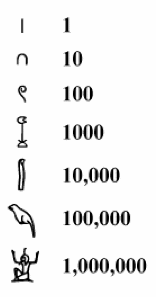 Source: www.math.wichita.edu
Source: www.math.wichita.edu
Representing the numbers one through nine
involved writing down 1 through 9 strokes side by side. An so representing very
large numbers became cumbersome. So 99 was written like this ![]() .Look at nine thousand nine hundred
and ninety nine.
.Look at nine thousand nine hundred
and ninety nine.

![]() . So you see that the numeral
representations can take up quite a bit of space pretty quickly.
. So you see that the numeral
representations can take up quite a bit of space pretty quickly.
Ancient Egyptian Calculations
So
how did the Egyptians use these symbols in their calculations? Lets start with addition. Lets say they
were adding one plus one well that was easy. One strike plus one stroke gives a
double stroke that is I plus I = II. Then representing I00 minus 1 we have
![]() minus
I =
minus
I = ![]()
For
multiplication the Egyptians used a system of doubling and halving . They were
really using a binary system in this case where the numbers 0 and 1 were only
two levels for the place holders To multiply any 2 numbers for example 32 times
15, you divide the first number by two until the answers reaches 1 and them
multiply the other number by 2 the same number of times that you divided the
first number by 2.
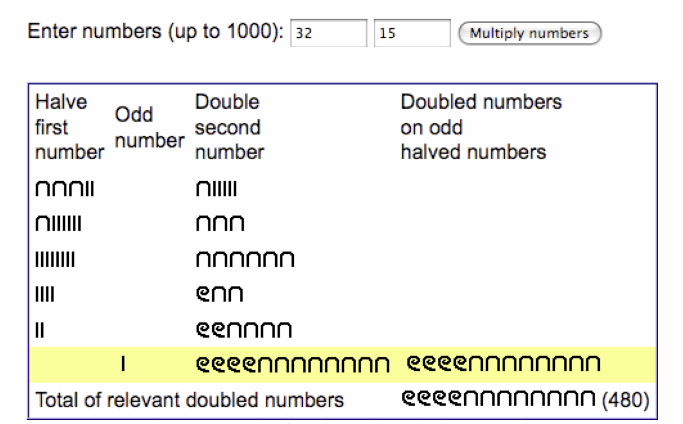
Diagram generated using an applet from
http://gwydir.demon.co.uk
If
it is not possible to divide the numbers evenly until it goes to one then you subtract
one before halving the first number.

Diagram
generated using an applet from http://gwydir.demon.co.uk
Since
the Egyptians did not base a base 10 system for multiplication their system
which was a binary system would seem rather cumbersome to us today. However it
works. It is easy because you only had to work with two levels 0 and 1. So
check this 0x0=0, 0x1=0,1x0=0,1x1=1, yes so easy. Thus you don’t have to add
any numbers on the zero lines because zero times any number is zero and given
that 1 times any number remain the same number than all that has to be done is
just to add the numbers to get the final answer.
Egyptian
Mathematics and Computers
Believe it or not, modern day computers do not use a
cumbersome ten digit decimal system to process information. Instead a computer
processes information in zeros and ones; exactly the same way that the same way
that Ancient Egyptians manipulated their number system. An information system needs at least
two characters to function and the binary system is the smallest one that can
be used. Even tough the binary system used more characters as place holders
Computers are a form of digital electronics and
digital electronics function in two states ‘on’ or off’. The levels of voltage in an electronic
device can be the indicator of ‘on’ of ‘off’. For example a transistor with no
voltage is considered off while a transistor with five volts is considered
‘on’. Some computer hardware such as CDs use dark spots on the surface to
indicate off and light spots on the surface to indicate ‘on’. Computer hard
disks are driven by magnetism but again there are only two states that they
operate in that is ‘on’ and ‘off’. The computer memory also has two states ‘on’
and ‘off’ which are achieved by changing electric charges in the capacitors. Because
the computer devices essentially have two states then it is pretty easy for
numbers to be encoded in the computer in a binary number system rater than a
decimal number system. Take for example a number like 18 in decimal number
system is equivalent to the number 10010. In computer language this is simply
‘on’, ‘off’, ‘off’, ‘on’, ‘off’. In this way all numbers can be manipulated in
the two different states of the computer when 1 is treated as ‘on’ and 0 is
treated as ‘off’.
Thus although the binary number system will contain
more digits than the decimal number system for the same number, the computer
can easily used a pattern similar to the ancient Egyptians to add, multiply,
subtract, and divide numbers very quickly. Also given that Ancient Egyptians
knew that all numbers can be expressed as a power of two and modern computer
programmers also know and use the same idea than we can say that there is a
logical link between what the ancients Egyptians already knew and what we use
today in our computers today. Ancient Egyptians never had to memorize a times
table and neither does a computer. Multiplication and division of any number is
achieved in both situations by manipulating all numbers as if using a binary
number system.
Take for example a calculation like 18 * 32 in the modern
day computer is
|
Power of 2 |
18 (in binary) |
32 doubling |
Multiply cool 2 by cool 3 then add
|
|
1 |
0 |
32 |
0 |
|
2 |
1 |
64 |
64 |
|
4 |
0 |
128 |
0 |
|
8 |
0 |
256 |
0 |
|
16 |
1 |
512 |
512 |
|
|
= 10010 |
|
Total = 576 |
Thus the computer multiplication is done like the
multiplication in ancient Egyptian Mathematics. In the above 1 indicates ‘on’
or ‘electricity’ present, while 0 indicates ‘off’ or no ‘electricity’ present.
Division is done in the reverse order 576 Ł 32 in computer mathematics is like the
following.
|
576 and powers of 2 |
32 doubling |
Matching levels |
|
1 |
32 |
0 |
|
2 |
64 |
1 |
|
4 |
128 |
0 |
|
8 |
256 |
0 |
|
16 |
512 |
1 |
In the above table the 32 is doubled until the
highest doubling less than 576 is reached. Indicate the level of the power of
two that corresponds to this number (512) by a 1. Subtract this number 512 from
576. Note that the remainder is 64. Notice where 64 line up with the powers of
2 column and indicate this by 1. Indicate by 0 the other powers of two levels.
Then the binary code for the answer is 10010, which is equal to 18 in the
decimal system.
Now using such a system the,
calculations can be done quite easily, pretty accurately and efficiently by the
computer. This is just like the Ancient Egyptians did it without the use of
memorizing times tables.
References
www.kerryr.net/pioneers/binary.htm
www. gwydir.demon.co.uk
www.math.wichita.edu